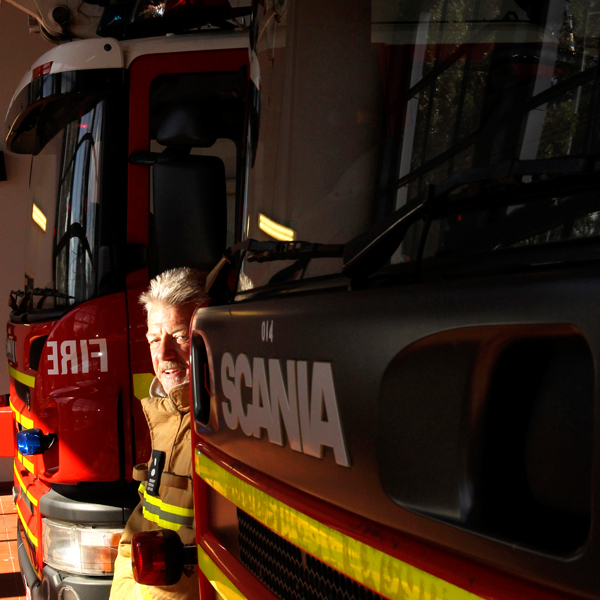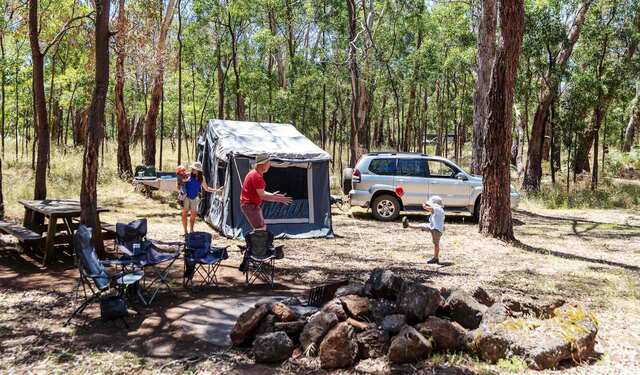Grant Reynolds spends a day with Footscray fire station’s ‘A’ Crew for a taste of life in the Metropolitan Fire Brigade. Pictures by Darren Howe.
IT may go down in history as the most exciting smouldering blanket I have ever seen. For the firefighters on ‘A’ crew based out of Footscray station, it was the punctuation mark in an otherwise uneventful day at the office.
At 11.56am on a sunny March Friday, the station alarm sounds, alerting two trucks and crews to a fire in Eleanor Street, Footscray.
Cue adrenalin, boyish excitement and no small amount of voyeuristic anticipation for what could be front-row seats at a raging inferno.
Yet the lead-up is far less dramatic and begins almost four hours earlier.
8am
The troops gather in the main communications room where senior station officer David Sinnamon and station officer Dominic Condon address the crew, briefing them on any overnight incidents and other information such as safety bulletins the crew needs before they start their day.
Old-timers like Sinnamon say technology has been the biggest change in the brigade, with the greatest impact on their work.
‘‘In the old days if someone saw a fire they had to find a phone box that worked. Now they have a video on YouTube by the time we get the call,’’ Sinnamon says.
8:15am
Each shift, the crews are required to check each and every piece of equipment to make sure it’s in good working order.
Footscray station has two pumper-tanker trucks and a truck mounted with a 37-metre ladder, known as a ladder-platform.
It was while testing a ladder platform that leading firefighter Wayne Hopkins saw a plume of smoke coming from Coode Island on the afternoon of August 21, 1991. It became one of Melbourne’s worst industrial fires.
Fully extended to the equivalent of 11 stories above the station on this clear, crisp autumn day, the ladder provides a postcard-like panorama of the city.
It can withstand wind gusts of up to 50 kilometres an hour. Today, what feels like a gentle breeze is registering close to 30km/h and the bucket is swaying like a leaf on a branch.
9am
They gather around a large dining table in the kitchen to devour toast and the day’s papers. Camaraderie abounds; some of the crew jokingly call A-crew’s elder statesman Sinnamon ‘‘granddad’’.
‘‘It’s like hanging around a group of friends the whole day who are happy to work together,’’ leading firefighter Bradley Pratt says.
‘‘We talk about everything that happens. If anyone has a problem most of the guys will talk about things that happen at station level and then we’ve got peer support groups and psychologists we can talk to.’’
The station is a home-away-from-home for up to 10 men, 24 hours a day, seven days a week, and each crew is expected to leave the station spotless for the next, which means each day has a good chunk of time spent cleaning.
‘‘Twenty-five years ago, firefighters would’ve lived here with their families,’’ says station officer Dominic Condon.
10.30am
The crew gathers in a training room for a refresher in first-aid techniques from visiting Ambulance Victoria paramedics.
Today’s class is about what emergency rural firefighters are more likely to encounter: snake bites.
They need to know such things to maintain their first-aid credentials and it’s likely firefighters will be first on the scene in the critical first hour after a person is bitten.
Some of the older guys admit medical response is a big change to their responsibilities from when they joined.
‘‘A burning building doesn’t go anywhere and so long as nobody is inside it’s fine, but when you have to work on human bodies [as part of EMR] it can be quite stressful. It can be a relief seeing ambulance there already,’’ Sinnamon says.
The younger generation know no different and take it in their stride.
‘‘We’ve been doing this for 11 years and people still wave us on,’’ leading firefighter Andrew Brough says. ‘‘We just say ‘we’re here to help’.’’
‘‘As long as you are confident in your skills it’s not a problem. But the community still hasn’t really grasped the fact that we’re capable of medical response.
‘‘EMR is a good thing. If you go to a car accident you can give 20 minutes’ oxygen, use defibrillation and do first aid; that wasn’t available 15 years ago.’’
If any of the crew suffers stress or trauma from dealing with horrific car accidents or trying to revive an unconscious child, it won’t go unnoticed.
‘‘We know each other pretty well and we know when someone is off their game and when someone is not their normal self. We’re so close you can tell if someone has issues at home or on the job,’’ explains Sinnamon.
11am
Firefighter Liam McDonald is two years into what is much like an apprenticeship. After about three years, and once he’s completed the required training, he’ll be promoted to the rank of qualified firefighter.
‘‘In the first year you’re taking so much in,’’ says McDonald. ‘‘You need to learn to step back and get rid of the tunnel vision. When there’s sirens going off at first you’re just worried about getting your gear on and getting on the truck.’’
It’s not easy getting into the brigade. After numerous tests including a psychometric test and physical exam, thousands of applicants are whittled down and the recruits undergo 17 weeks’ training before joining a crew on-station.
From there, it’s roughly three years before they become a qualified firefighter, then leading firefighter. Spare time during the day for the rookie is easily filled with skills training to prepare them for what might happen.
Firefighters like Dave Sinnamon were there when Coode Island went up in 1991 and when Butler Transport depot on Dynon Road Footscray caught fire, spewing toxic fumes into the air on April 12, 1985.
‘‘We drove into the yard and three massive explosions blew the roof off the place.’’
11.56am
Conversation has turned from previous battles to lunch, when the alarms go off.
The call is to an apartment in a two-storey block in Eleanor Street, Footscray, and two trucks have been mobilised — this is real.
Within seconds, the crews are aboard the trucks and we’ve wheeled out of the station and are racing full throttle up Droop Street.
Leading firefighter Bradley Pratt has thumbed through the Melway and is giving firefighter McDonald directions to the blaze.
Traffic parts before us and we’re through the busy intersection on Gordon and Ballarat streets like a hot knife through butter, arriving at the fire site, opposite the Western Hospital, within three minutes of the alarm.
Smoke is coming from a second floor balcony. It’s not exactly billowing, but there’s enough to make other residents and passers-by worry.
A firefighter is up a ladder and douses a smouldering blanket. The anticlimactic event is over within 10 minutes of the call-out.
The firefighters quickly point out a fire like this could easily have caught on and spread inside the building as no one was home at the time.
Sinnamon slips a note under the door for the occupier and he’ll fill out a fire report back at the station. ‘‘The fire report takes longer than putting out the fire,’’ he jokes.
If the resident isn’t insured they’ll foot the bill for the call-out.
2.30pm
Fire crews have a wealth of technology and training at their disposal, but it can all be of no avail without access to water.
A pumper-tanker, like the two at Footscray, carries 1300 litres of water and the hand-held hose reels mounted on the sides of the truck can spray 200 litres a minute on the blaze, while a monitor mounted at the rear can blast 3800 litres per minute.
You don’t need be a maths whiz to work out that water won’t last long at a decent fire.
In that case, the first truck on scene will pour water on the fire while the second will connect to the nearest hydrant then take over while the first truck finds a water source.
It’s critical then that firefighters know the location of hydrants and that they aren’t covered in grass, concreted over or filled with dirt or rubbish.
It’s a dreary task, but this afternoon Sinnamon takes a small crew out into the suburbs to check hydrants and place new reflective markers on telephone poles if needed.
This is the grinding routine and monotony that contrasts the high excitement in the life of a firefighter.
On the way back to the station, Sinnamon spots a couple struggling to move a couch through a doorway of their home.
He orders a quick U-turn and the stunned couple are confronted with strong, willing firefighters who manhandled the obstinate piece of furniture upstairs.
‘‘Did someone call triple zero?’’ the woman asks.







